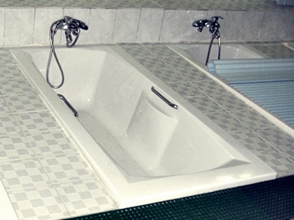Even while formal evaluation cannot be replaced, it's surprising how many conditions a few simple cares like hydrotherapy can benefit. Yet optimal health only comes when the needs of our whole being are met. While we often hear about physical and mental health, spiritual needs tend to be overlooked. This site takes its inspiration from the healing ministry of Christ, who cared for people in mind, body, and spirit. For more about how water provides symbolisms that explain his spiritual healing influence, or other spiritual questions, see this post at my other website, www.CosmoQuestions.com.
Hydrotherapy Science

The effectiveness of hydrotherapy treatments and the understanding of its mechanisms of action are based on scientific principles. Studying these principles leads to insight on how best to use water therapeutically, as well as to scientific inquiry that may help to establish new uses of hydrotherapy. It is the purpose of hydroreference.com to encourage research and inquiry into hydrotherapy science.
~
To revisit Wikipedia’s definition for a moment, hydrotherapy involves “...therapeutic methods that take advantage of the physical properties of water, such as temperature and pressure, for therapeutic purposes, to stimulate blood circulation and treat the symptoms of certain diseases 1."
These few short words touch on some key principles of the science behind hydrotherapy. Water affects physiological processes, such as circulation, through its physical and mechanical properties and by transferring temperature through conduction or convection.
The mechanical effects of moving or turbinated water enable it to cleanse and debride wounds, as well as to decrease pain through stimulating touch receptors in the skin which override the stimulus of smaller pain receptors, leading to an overall decreased sense of pain according to the gate theory 3.
Perhaps most significantly, however, water affects the human body through the transfer of temperature changes which stimulate physiologic responses. Temperature changes of only a few degrees either locally or systemically can cause physiologic changes such as increased blood flow and stimulation of the autonomic nervous system.
These responses are called “thermoregulatory” because the human body needs to be maintained within a very narrow temperature range for health and safety 4. This being the case, whenever there is a perceived threat of cold or heat which has the potential to damage tissues or change the temperature of the blood the body quickly responds with physiologic changes to counteract the perceived danger.
In the case of a cold threat blood is shunted toward the internal organs through vasoconstriction of the periphery, there is sympathetic stimulation of the autonomic nervous system, and shivering starts, among other things. If the threat is prolonged or in combination with other factors such as hunger or advanced age, it can exceed the body mechanism’s capabilities to prevent heat loss, and result in hypothermia 2. However, in the case of the purposeful use of cold within hydrotherapy, the short cold exposure which is typically preceded by a preparatory warming phase can result in invigorating, therapeutic effects rather than tissue damage or hypothermia.
Responses to heat include sweating, parasympathetic stimulation of the autonomic nervous system, as well as peripheral vasodilatation which brings blood toward the surface where heat may be released in contact with the environment 4, 7.
Studying these physiological response mechanisms and how to stimulate them through the use of hot and cold treatments can provide valuable information about what may be done to bring about the desired therapeutic effects for any target tissue area.
Based on the above principles, a summary of some of the major beneficial effects of hydrotherapy treatments are as follows 5, 6;
Wound cleansing/debridement
Reduced joint pain and stiffness
Relaxation/stress reduction
Reduction of muscle tension
General pain reduction
Promotion of digestion
Promotion of healthy circulation
Enhanced immune system function
Enhanced metabolic function
In the future, a more thorough discussion of the mechanisms mentioned above will be presented under this section, with special emphasis on therapeutic circulatory, immune, nervous and metabolic responses to hydrotherapy, as well as a more specific discussion of the effects of treatments at various temperatures.
~
Request for Feedback
Because Hydrotherapy Interest Group is committed to continual improvement in seeking to provide accurate information on www.hydroreference.com, we invite anyone who is aware of pertinent information, current research about hydrotherapy or conditions effected by hydrotherapy to please contact HIG.
It should be noted that hydrotherapy treatments can result in serious injury or complications under some circumstances. Prior medical advice should always be sought and extreme caution taken when performing any kind of hydrotherapy treatments for individuals with chronic diseases or decreased skin sensitivity. Hydroreference.com does not recommend the use of hydrotherapy for any condition without prior consultation with a physician or qualified healthcare provider.
References:
1. Hydrotherapy [Internet]. Wikipedia: the free encyclopedia. St. Petersburg (FL): Wikimedia Foundation, inc. 2001 – [updated 2013 Jan 10; cited 2013 Feb 8]. Available from: http://en.wikipedia.org/wiki/Hydrotherapy
2. Stocks JM, Taylor NA, Tipton MJ, Greenleaf JE. Human physiological responses to cold. Aviation, Space, and Environmental Medicine [Internet]. 2004 May [cited 2013 Feb 8]; 75(1): 444-457. Available from: http://www.ingentaconnect.com/content/asma/asem/2004/00000075/00000005/art00011
3. Fioravanti A, Cantarini L, Guidelli GM, Galeazzi M. Mechanisms of action of spa therapies in rheumatic diseases: what scientific evidence is there? Rheumatol Int. [Internet]. 2011 Jan [cited 2013 Feb 8]; 31(1):1-8. Available from: http://link.springer.com/article/10.1007%2Fs00296-010-1628-6
4. Diaz M, Becker DE. Thermoregulation: Physiological and Clinical Considerations during Sedation and General Anesthesia. Anesth Prog. 2010 Spring; [cited 2013 Feb 8]; 57(1); 25-33. Available from:
http://www.ncbi.nlm.nih.gov/pmc/articles/PMC2844235/pdf/i0003-3006-57-1-25.pdf
5. Davis DL. Hydrotherapy and Aquatic Therapy [Internet]. Spine Universe [updated 2012 Dec 13; cited 2013 Feb 8]. Available from:
http://www.spineuniverse.com/treatments/physical-therapy/hydrotherapy-aquatic-therapy
6. Hydrotherapy [internet]. American Cancer Society; 2011 Mar [cited 2013 Feb 8]. Available from:
7. Saeki Y. The effect of foot-bath with or without the essential oil of lavender on the autonomic nervous system: a randomized trial. Complement Ther Med. 2000 Mar;8(1):2-7. PubMed PMID: 10812753 Available at: http://www.ncbi.nlm.nih.gov/pubmed/?term=%22The+effect+of+foot-bath+with+or+without+the+essential+oil+of+lavender+on+the+autonomic+nervous+system%3A+a+randomized+trial.%22